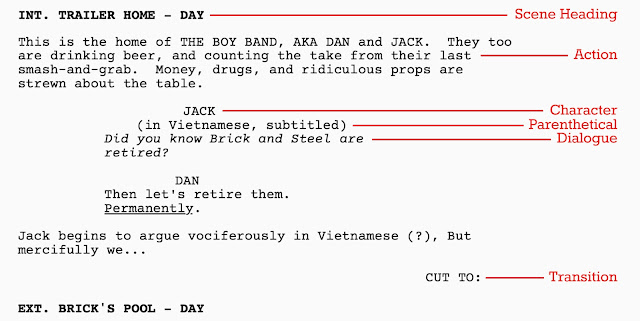Here is a research that Chelsea had conducted on script-writing. This blogpost is written by Chelsea.
What is scriptwriting?
Scriptwriting is a detailed narrative that outlines the story, characters, dialogue, and other elements essential to the production of a movie. It provides a blueprint for filmmakers, including directors, actors, and producers, to follow during the filmmaking process. A screenplay format is essentially used to express the story visually.
In general, here is what a script/screenplay should look like:
All screenplays are built out of the same core formatting elements. However, different genres may have look different. The two main pieces of a script that fill up pages are usually action lines and dialogue. But genres like comedy for instance, tend to place a greater emphasis on dialogue while other genres, like action, often focus more on action lines. Different films make use all kinds of different story structures, but the core look and functionality of screenplay formatting remains the same across all story structures and genres.
Now I will get into depth to dissect each part of a screenplay or script. There are 6 elements in a script which includes: scene heading, action, character, parenthetical, dialogue and transition. Here is what they look like in a standard script format:
1). Screen heading (also known as Slugline)
↪ Marks any change in location or time
↪ To create a scene heading in slugline, begin with a new line with one of the prefixes: INT. (Interior), EXT. (Exterior), INT./EXT. (scenes in vehicles)
2). Action
↪ Tells the reader what happens on the screen
↪ Includes descriptive words
3). Character
↪ They are in uppercase and are followed immediately by dialogue
↪ Example:
4). Dialogue
↪ Comes right after character
↪ Dialogue cannot exist without a character element immediately before it
5). Parenthetical
↪ Elements wrapped in parentheses, and follows a character or dialogue element
↪ If you type an open parentheses (after a character element, slugline adds the closing parentheses) and places the cursor between them so you can type your parenthetical
↪ Example:
6). Transition
↪ Indicate special information about how one scene transitions to another
↪ They are in uppercase and end in TO:
or begin the line with a > symbol for example, > FADE TO BLACK.
7). Emphasis
↪ To italicize. wrap the text in *asterisks.*
↪ To create bold text, wrap in **double asterisks.**
↪ To underline something, wrap it in _underscores_.
Since I'm writing a crime documentary script, unlike films. The format may be different, hence I also searched up tips for writing a documentary script from one of the famous documentary filmmaker, Ken Burns. Below is my summary:
1). Make the use of the narrative elements: It is important to tell the dynamic of the story when possibly can when writing a script. Don't be afraid to use narrative elements to add dimension of the documentary script instead of all narration conversation and talking heads.
2). Use earlier drafts to determine your narrative arc: The first drafts are immensely important in determining the story's arc as what comes out of the first draft is telling louder than anything else what the potential film has the possibility of looking like that can emerge throughout the filmmaking process.
3). Find impactful ways to tell your story: Instead of focusing on statistics and facts, try to reword and deliver it in a kind of poetic vehicle that makes sense to people. It is important to find a way to personalise the material with the use of words (you can still think about real issues while using creative language).
4). Build structure around facts: It is better to gain facts around multiple resources (such as interviews with people). If you don't have a strong structure based on fact, then it will lead to conjecture, theories and conspiracies.
5). Use different narrative points of view: The third person narrator describes what occurs while performing almost objectively, while the first person narrative has a certain intimacy suggesting that such events happened to them. Combining the two narrative perspectives will result in something more fuller, richer and more dimensional.
6). Words are not set in stone (or not permanent): The writer should not worry about whether there are images to illustrate as that is not the writer's job. The writer's job is to just write the scene. The script may continue to change during the post-production process, up until finish editing the final film.
7). Use caveats when the facts are missing: Instead of saying, "They did this or they did that." You can say, "He may (or would) have been looking for." It is a must to figure out ways to use language to communicate something that isn't absolutely true or proving something.
---------------------------------------------------------------------------------------------------------------------------------------------------------------
Resources used:
↪ https://www.studiobinder.com/blog/screenplay-example-download/
↪ https://www.studiobinder.com/blog/what-is-script-writing/
↪ https://slugline.co/basics#:~:text=%E2%80%9CEXT%E2%80%9D%20stands%20for%20%E2%80%9CExterior,INT.%2FEXT.
↪ https://www.masterclass.com/articles/ken-burns-shares-tips-for-writing-a-documentary-script


No comments:
Post a Comment